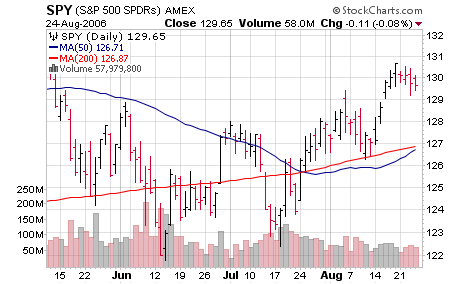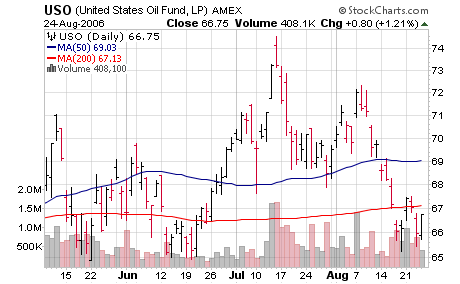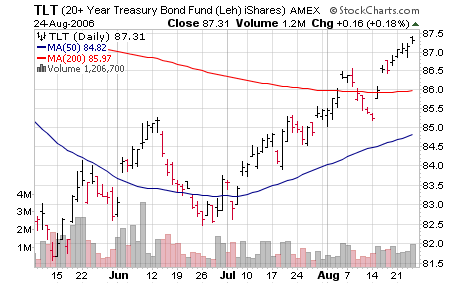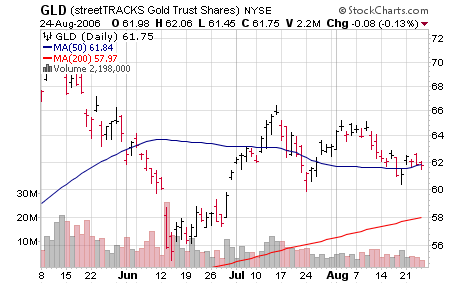When in doubt, stay out
One of my favorite trading and investing rules is
one of W.D. Gann’s which goes, “when in doubt stay out, and don’t get back in
until you’re sure.â€
A favorite analogy story I often tell is of the small Columbian village that had
a dirt road airport without lights but needed an emergency night-time landing.
Every person in the village who had a car was called upon to drive it to a
specific place and then aim at a slightly different angle than the other cars,
all with headlights on. By combining many points of lights together the village
created enough light for the plane to land.
This rule and analogy point to what we’re striving to do in the markets all the
time. First we’re only investing when we’re very sure of the scenario, trade, or
investment vehicle that we’re investing in — otherwise we stand aside and earn
interest. Second we apply many points of light, many different methodologies of
market analysis and try to find periods and asset-classes and sectors where many
different analyses point to the same trend developing in order to build
reliability.
This year we’ve been talking about macro policy more than at any time since the
2002-2003 period when we emphasized the most massive concerted global policy
stimulus in the post WWII era and what effect that was likely to have on
markets. Macro analysis is one point of light we use frequently to give
ourselves an edge — and at times it is nearly mandatory to investment survival.
We also nearly always talk a-lot in these columns about breadth, plurality,
supply-demand volume analysis, and reading what the majority of the market is
doing. These are other points of analysis light that can help us see through the
thick fog of an unknown future.

Our certainty and therefore allocation tends to be more aggressive when several
points of light all lead to the same trend, and we’ve found a good risk/reward
instrument for investing or trading in that trend. But likewise, when few points
of light point definitively in the same clear direction, our certainty and
allocation should be less aggressive. Many traders and investors make the
mistake of not understanding how it is just as critical to pinpoint times to be
mostly on the sidelines as it is to pinpoint times to be heavily invested. When
a period of uncertainty develops, many novice traders keep trading at the same
level of allocation and aggressiveness as during times when it is fairly easy to
make money in a strong clear reliable trend. Sometimes they may get lucky and do
well, but usually such environments lead to high volatility and big drawdowns.
Pinpointing difficult environments is key DEFENSE for investing.

Currently I would rate the macro environment as not highly reliable (except
perhaps for bonds and
(
TLT |
Quote |
Chart |
News |
PowerRating), which are likely to beat cash as the US slows
down and have broken out of a base recently). The US economy is slowing down.
Some measures of housing in particular are falling at levels that have usually
indicated a recession ahead. Likewise some monetary variables like monetary base
growth, the ratio of lagging/coincident indicators, and the 2/10 yield curve
have reached levels that have usually preceded recessions or substantial
slowdowns in growth. Normally such a combination of indicators suggesting a
sharp slowdown will lead to slower than expected growth ahead and a focus by
markets on the risk of recession, meaning some volatility and downside for
stocks. On the other hand if the rest of the economy can hold up fairly well to
a housing slowdown, and if inflation gauges begin to turn down again quickly,
the US economy may well witness only a mild growth slowdown, and markets may be
able to look through the weakness and focus on the likely end of rate hiking
ahead. From a macro viewpoint, the outlook is not very clear or reliable in the
intermediate-term. And there are HUGE potential risks from geopolitical
considerations.

Similarly, the internal market breadth, volume, and plurality indications are
not clearly definitive. The progress of advance/declines and NH/NL’s has not
been as substantial as would normally lead a sustained advance in the market as
a whole. Our own Top RS/EPS new highs have not led to a broad number of stocks
breaking out and meeting our criteria for possible buy candidates. Nor have new
lows or downside action been significant enough for us to suspect a major down
wave is imminent. Supply and Demand measures of volume are not clearly
directional either. Some groups are trending higher, and some, like housing
related groups and some retails, are trending clearly down.
In relation to these critical points of light, there is no clear signal and no
clear direction that I can discern. In other words, the outlook is unclear,
we’re not sure, and when in doubt we should mostly stay out of the markets. As
much as anxious traders and investors hate to hear that, it is the best advice I
can give for the current environment for investors. Remain defensive and heavily
sidelined until the environment clearly improves and the outlook for a strong
trend become clear.

Investors should continue to skeptically let market action be the guide. Strong
rallies in the major averages accompanied by high volume to create a couple more
follow-through days would be the first sign of more upside ahead. The real
excitement may not come until the breadth of Top RS new highs starts to expand
broadly and stocks meeting our runaway up fuel criteria begin to break out with
some plurality. Until then, we still suggest keeping your powder mostly dry. We
continue to suspect that breaking above 1320-27 and making new highs will be
difficult for the market to do unless better volume and breadth materializes. We
continue to regard this as a TREACHEROUS ENVIRONMENT where CAPITAL PRESERVATION
SHOULD BE PARAMOUNT. Don’t allocate heavily to anything that doesn’t scream at
you.
Sometimes the sidelines are the best place to be. We suspect we’re still in one
of those times. Conflicting forces continue to grow, and high odds sustainable
moves don’t appear likely to materialize just yet. Until they do, we suggest
mostly keeping your powder dry and watching events transpire closely.

Our model portfolio followed in TradingMarkets.com with specific entry/exit/ops
levels from 1999 through May of 2003 was up 41% in 1999, 82% in 2000, 16.5% in
2001, 7.58% in 2002, and we stopped specific recommendations up around 5% in May
2003 (strict following of our US only methodologies should have had portfolios
up 17% for the year 2003) — all on worst drawdown of under 7%. This did not
include our foreign stock recommendations that had spectacular performance in
2003.
Our US selection methods, our Top RS/EPS New Highs list published on
TradingMarkets.com, had readings of 35, 23, 20, 26 and 14 with 9 breakouts of 4+
week ranges, no valid trades meeting criteria, and no close calls. This week,
our bottom RS/EPS New Lows recorded readings of 11, 8, 9, 13 and 11 with no
breakdowns of 4+ week ranges, no valid trades and no close calls. The “modelâ€
portfolio of trades meeting criteria has some time back exited all positions and
is 100% in cash.
Mark Boucher has been ranked #1 by Nelson’s World’s Best Money Managers for
his 5-year compounded annual rate of return of 26.6%.
For those not familiar with our long/short strategies, we suggest you review my
book “The Hedge Fund Edge“, my course “The
Science of Trading“, my video seminar, where I discuss many new techniques,
and my latest educational product, the
interactive training module. Basically, we have rigorous criteria for
potential long stocks that we call “up-fuel”, as well as rigorous criteria for
potential short stocks that we call “down-fuel”.
